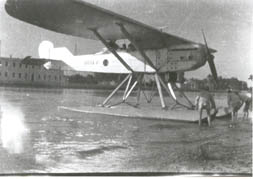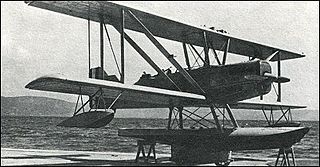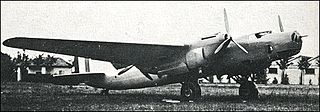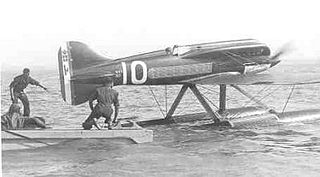
The Sopwith Tabloid and Sopwith Schneider (floatplane) were British biplanes, originally designed as sports aircraft and later adapted for military use. They were among the first successful types to be built by the Sopwith Aviation Company. The "Tabloid", so named because of its small size, caused a sensation when it made its first public appearance.

The Fiat CR.1 was an Italian biplane fighter aircraft of the 1920s. Of wood-and-fabric construction, it was designed by Celestino Rosatelli, from whom it gained the 'CR' designation. Its most distinctive feature was that the lower wings were longer than the upper ones.

The SIAI S.8 was an Italian 1910s two-seat reconnaissance flying boat.

The Breda A.7 was a reconnaissance aircraft developed in Italy for use by the Regia Aeronautica in 1929. It was a braced parasol monoplane of conventional configuration with tailskid undercarriage. The pilot and observer sat in tandem, open cockpits. A single prototype of a long-range example, originally designated A.7 Raid and later A.16 was also constructed, but the air force showed no interest in it.

The Savoia-Marchetti SM.78 was an Italian bomber/reconnaissance biplane flying boat of the early 1930s.
The Piaggio P.32 was an Italian medium bomber of the late 1930s, produced by Piaggio, and designed by Giovanni Pegna. It was a modern design for its time, but was a failure due to lack of powerplants commensurate with its high wing loading.

The Piaggio P.6 was an Italian catapult-launched reconnaissance floatplane designed and built by Piaggio for the Regia Marina.

The Savoia-Marchetti S.65 was an Italian racing seaplane built for the 1929 Schneider Trophy race.

The Piaggio P.8 was an Italian reconnaissance floatplane designed and built by Piaggio for the Regia Marina.
The Piaggio P.23M was an Italian commercial transport aircraft prototype designed and built by Piaggio.

The Piaggio P.50 was an Italian prototype heavy bomber designed and built by Piaggio for the Regia Aeronautica.

The Macchi M.67, was an Italian racing seaplane designed by Mario Castoldi and built by Macchi for the 1929 Schneider Trophy race.

The Macchi M.17 was an Italian racing flying boat built by Macchi for the 1922 Schneider Trophy race.

The SIAI S.51, Savoia Marchetti S.51 or Savoia S.51 was an Italian racing flying boat built by SIAI for the 1922 Schneider Trophy race.

The Caproni Ca.124 was a 1930s single-engine Italian reconnaissance and bomber seaplane.

The CANT Z.515 was a twin engine monoplane floatplane designed and built for maritime reconnaissance in Italy at the start of World War II. It did not go into service.
Giovanni Pegna was an important figure in the development of Italian aviation. He was the head of the construction department of Piaggio and later of the Officine Meccaniche Reggiane, a subdivision of Caproni.
The CANT 12 was a flying boat and training aircraft that was produced in Italy in the 1920s.

The CANT Z.505 was a prototype trimotor transport floatplane built by CANT in the 1930s.


















